Get an in-depth understanding of Git's various workflows
This article will introduce you to Git, introduce the basic knowledge of git, and various workflows based on git. I hope it will be helpful to you!

Through this article you can learn:
- The origin of git
- Basic knowledge of git
- The basic method of gitflow process
- Multiple workflows based on git
Before talking about Git Flow, let’s talk about other things first
What is a version?
Edition refers to the printing edition, and the edition is the printed book; edition is a title used to describe various forms, states or contents of the same thing that are different from each other.
In other words, as long as anything is differentiated, it will involve the concept of version. However, the versions we are talking about here, including the things we will talk about later, should all be meaningful versions. For example, Xiao Ming January 1 From February 1st to January 31st, a planning document was revised every day. On February 1st, Xiao Ming’s Party A said that the previous version was better. At this time, for Xiao Ming, what was the previous version? Maybe it was the last plan that Xiao Ming sent to Party A, or maybe it was the last plan that Party A said was okay, but Xiao Ming may not remember the specific date on which the plan was revised to Party A.What are the common version controls?
copy The way files are distinguished by name, the undo/forward function of this editor, and the use of professional tools such as svn, git, etc. all belong to the category of version control. Different version controls have different uses, such as text editors. Withdraw, you can easily undo this modification, such as copying files, which can allow new and old files to exist at the same time for easy comparison, but these methods are too simple, and the intermediate processes are temporary things, which are not enough to serve as a modification history reference or Treat it as a complete version. For this, some professional tools are needed, such as centralized version management systems SVN, CVS, distributed version management systems BitKeeper, Git, etc.-
Git development background
Like many great things in life, Git was born in an era of great strife and innovation. The Linux kernel open source project has a large number of participants. The vast majority of Linux kernel maintenance work was spent on the tedious task of submitting patches and saving archives (1991-2002). By 2002, the entire project team began to use BitKeeper, a proprietary distributed version control system, to manage and maintain code.
By 2005, the partnership between the commercial company that developed BitKeeper and the Linux kernel open source community ended, and they took back the Linux kernel community's right to use BitKeeper for free. This forced the Linux open source community (especially Linux creator Linus Torvalds) to develop their own version system based on the lessons learned from using BitKeeper. They set several goals for the new system:- Speed
- Simple design
- Strong support for non-linear development models (allowing thousands of Branches of parallel development)
- Fully distributed
- Ability to efficiently manage ultra-large-scale projects similar to the Linux kernel (speed and data volume) Since its birth in 2005, Git has matured and matured, becoming highly user-friendly while still retaining the goals set in its early days. It's fast, great for managing large projects, and has an incredible non-linear branch management system (see Git branches).
In 1991, Linux developed the Linux system, an open source project. It used the method of sending source files with patches by email for writing and development, and Linux himself merged them manually;
In 2002, BitKeeper reached an agreement with the Linux community to allow the Linux community to try BitKeeper for free. Due to the free trial, the content of the agreement is more about protecting BitKeeper itself.
In 2005, BitKeeper was dissatisfied with the Linux community's destruction of the agreement (to put it bluntly, it was decompiling BitKeeper, trying to make a cracked version or other), and terminated cooperation;
Same as 2005, Linux spent 2 weeks to develop the first version of Git, and used Git to manage Linux code within a month;
Git basic knowledge
Workspace, Temporary Storage Area (Index), Repository (Repository)
# 创建并进入 testGitFlow 目录 # 此时 testGitFlow 就是我们的工作区(Workspace),也就是工作目录 $ mkdir testGitFlow && cd testGitFlow # 初始化 git 仓库 # 此时目录中增加了 .git 目录,.git 目录就是 git 仓库,不属于工作区 $ git init # 新增两个文件 $ echo 111 > a.txt $ echo 222 > b.txt # 添加两个文件到暂存区/索引(Index) $ git add . # 把索引中的两个文件添加到版本库(Repository) $ git commit -m 'init'
Several concepts involved above:
Workspace: A simple understanding is our project Directory
Index: A simple understanding is the area where content to be submitted is stored
Repository: Version repository
Commit, Tree, Blob objects
# 通过 git log 查看版本
$ git log
>
commit 2b304a56998989dbcfd77f370f4b43fcad9e5872 (HEAD -> master)
Author: huihuipan <huihuipan163@163.com>
Date: Mon Feb 27 17:56:53 2023 +0800
init
# 通过 git cat-file 查看 commit 信息
# 查看 commit 类型
$ git cat-file -t 2b304a
> commit
# 查看 commit 内容
$ git cat-file -p 10d717
>
tree 4caaa1a9ae0b274fba9e3675f9ef071616e5b209
author huihuipan <huihuipan163@163.com> 1677491813 +0800
committer huihuipan <huihuipan163@163.com> 1677491813 +0800
init
# 可以发现有 tree, author, committer 等信息
# 继续查看 tree 内容
$ git cat-file -t 4caaa1
> tree
$ git cat-file -p 4caaa1
>
100644 blob 58c9bdf9d017fcd178dc8c073cbfcbb7ff240d6c a.txt
100644 blob c200906efd24ec5e783bee7f23b5d7c941b0c12c b.txt
# 可以发现有 blob 信息
# 继续查看 blob 内容
$ git cat-file -t 58c9bd
> blob
$ git cat-file -p 58c9bd
> 111
# 可以看到里面存储的是 a.txt 的内容 Several concepts involved in the above:
commit: commit records the submitted version
tree: tree records the directory structure and file name under different versions
blob: blob record file content
At this time our git project structure is as follows
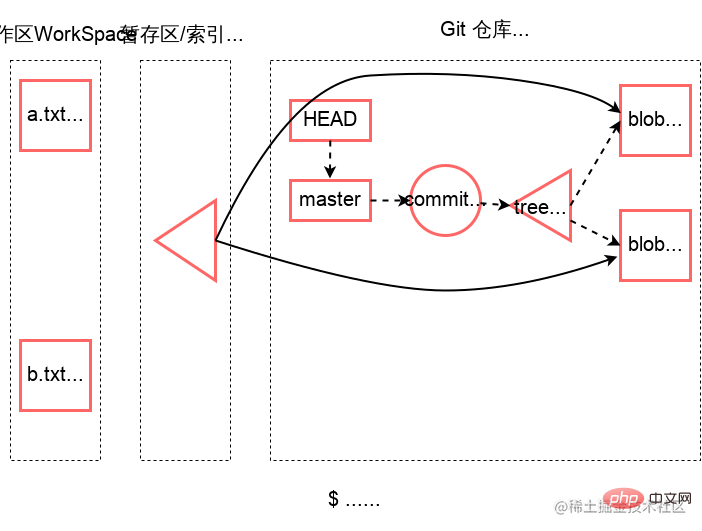
What happens when you modify the file and submit the commit?

- First of all, the content of a.txt is modified from 111 to 333. At this time, the git warehouse has not changed, but the contents of the workspace and the index do not match;
- Execute the git add command
- The git warehouse creates a new blob node based on the new a.txt content (333) and records the a.txt content
- The index changes from the old The blob points to the new blob
- Execute the git commit command
- Generate the tree object based on the status of the index
- According to the newly generated tree object and the previous A commit object, generates a new commit object
- Move the branch pointer from the old commit object to the new commit object
HEAD, Branch, Tag
Branch: is the pointer pointing to Commit. Every time a new commit is submitted, the current Branch will point to the latest commit;
HEAD: Pointer to Branch. When checkout reaches a non-branch, it will prompt It is in the detached head pointer state, and you can do some experimental actions. ;
Tag: Pointer to Commit, used as a label, usually used to record a fixed version, and can also be understood as an alias for a specified commit;
We can learn from the above that the version management granularity of git reaches the file level, and diff can be obtained by comparing blobs. This also leads to a development thought. When our program design When the basis is a relatively small granularity, subsequent development and expansion will be more flexible. In fact, git's operation of commit is also very flexible, so flexible that accidents may occur if you are not careful.
Checkout, Merge, Rebase, Fetch, Pull
checkout checkout: Check out HEAD to the specified branch or commit, Or check out the contents of a specified file of a specified version. Since checkout carries too many functions in git, all switching branches have exclusive commands switch.
merge merge:
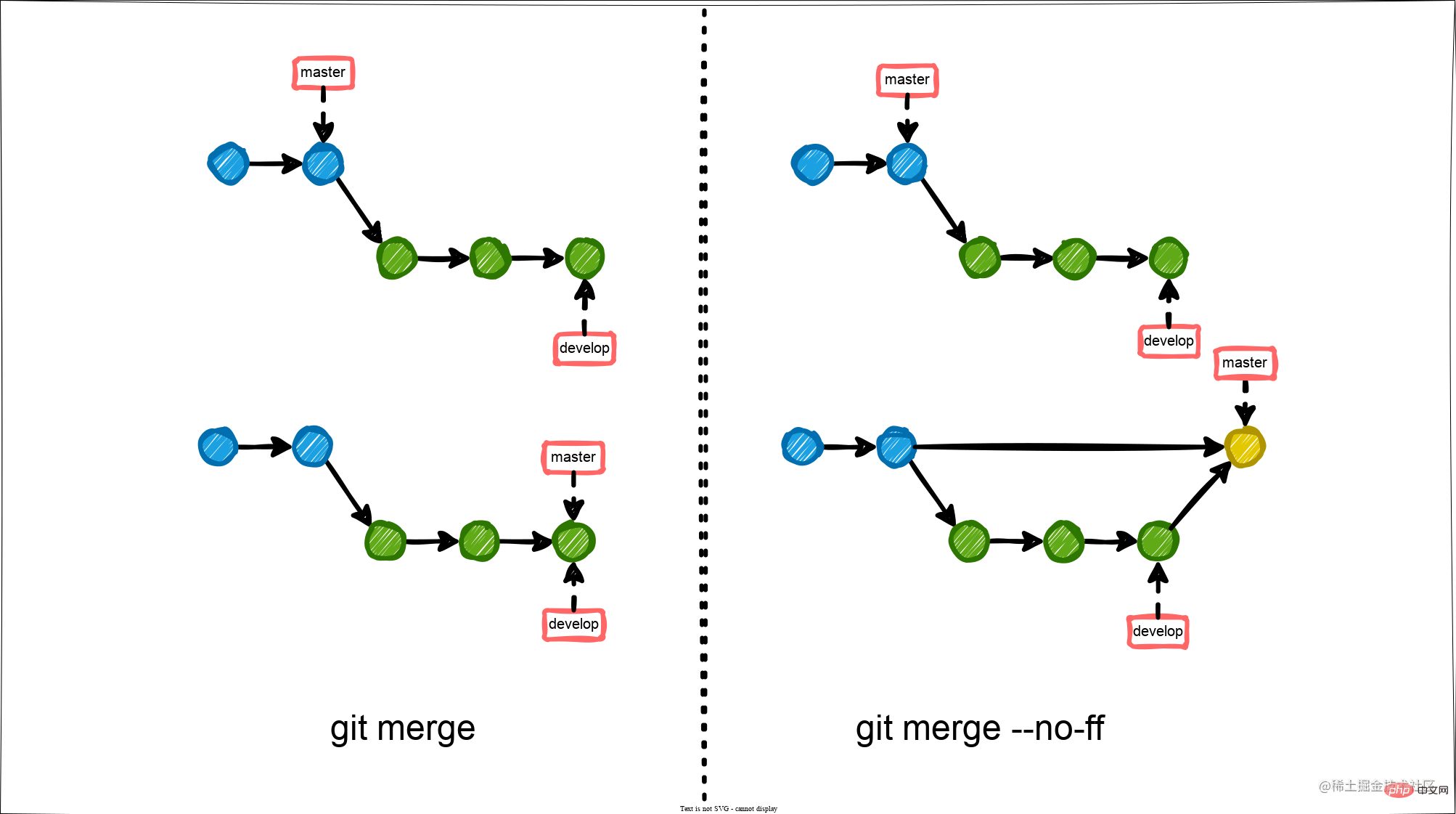
##rebase rebase: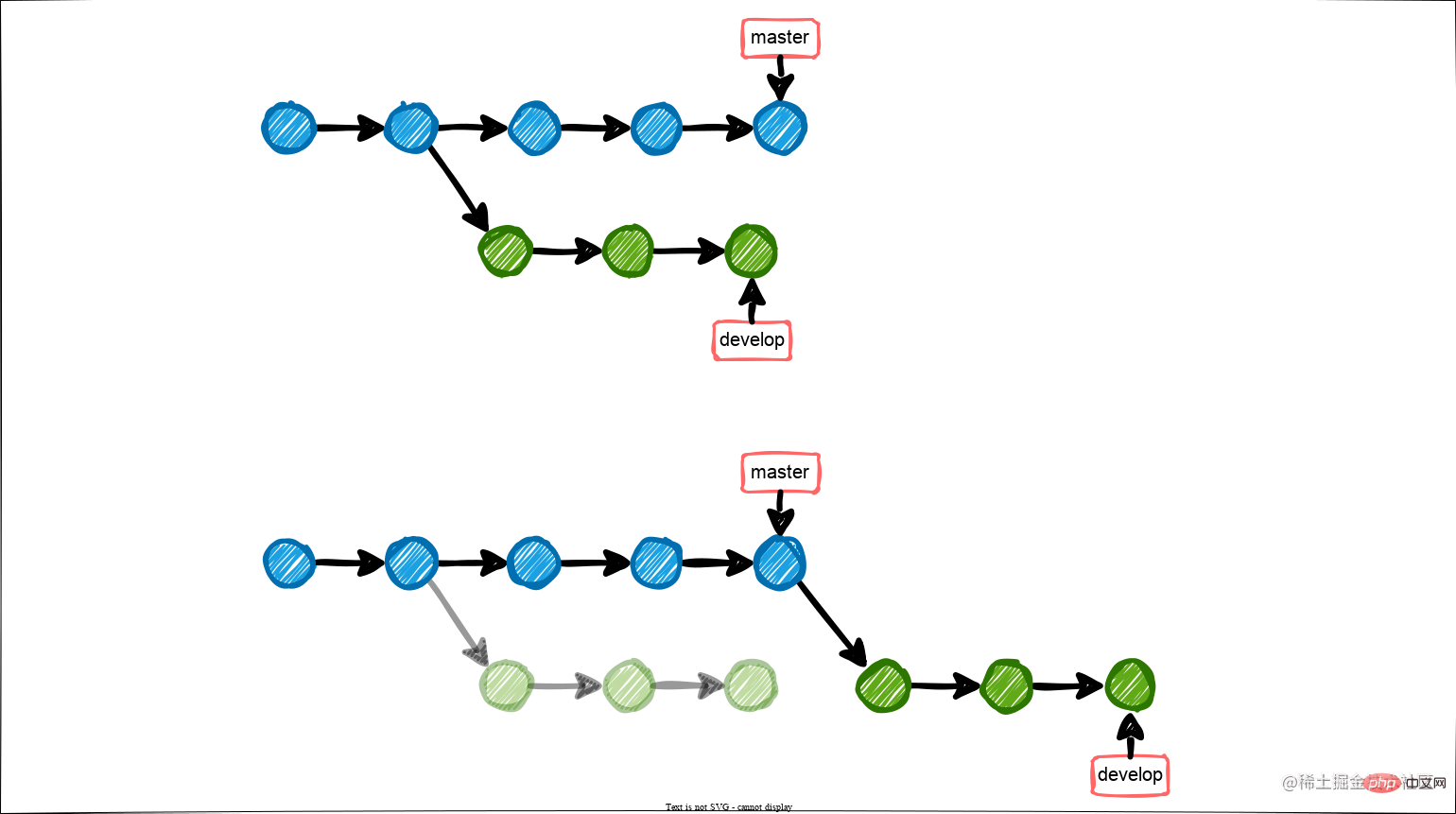
fetch: Download objects and references from another repository, such as a remote library
pull: git pull = fetch merge
based on Several workflows of GitGit Flow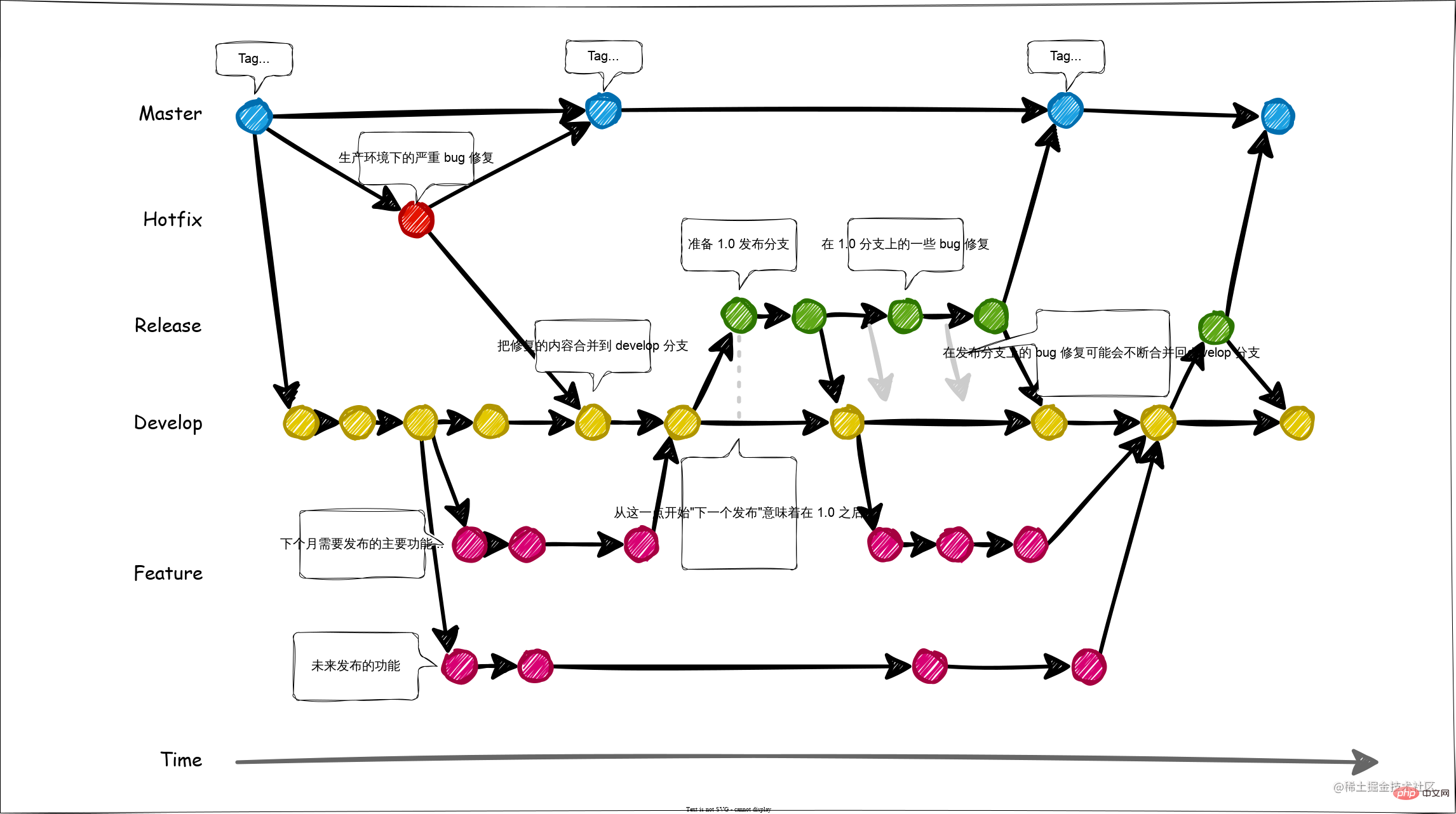
Vincent Driessen in 2010 An article written in
"A successful Git branching model"
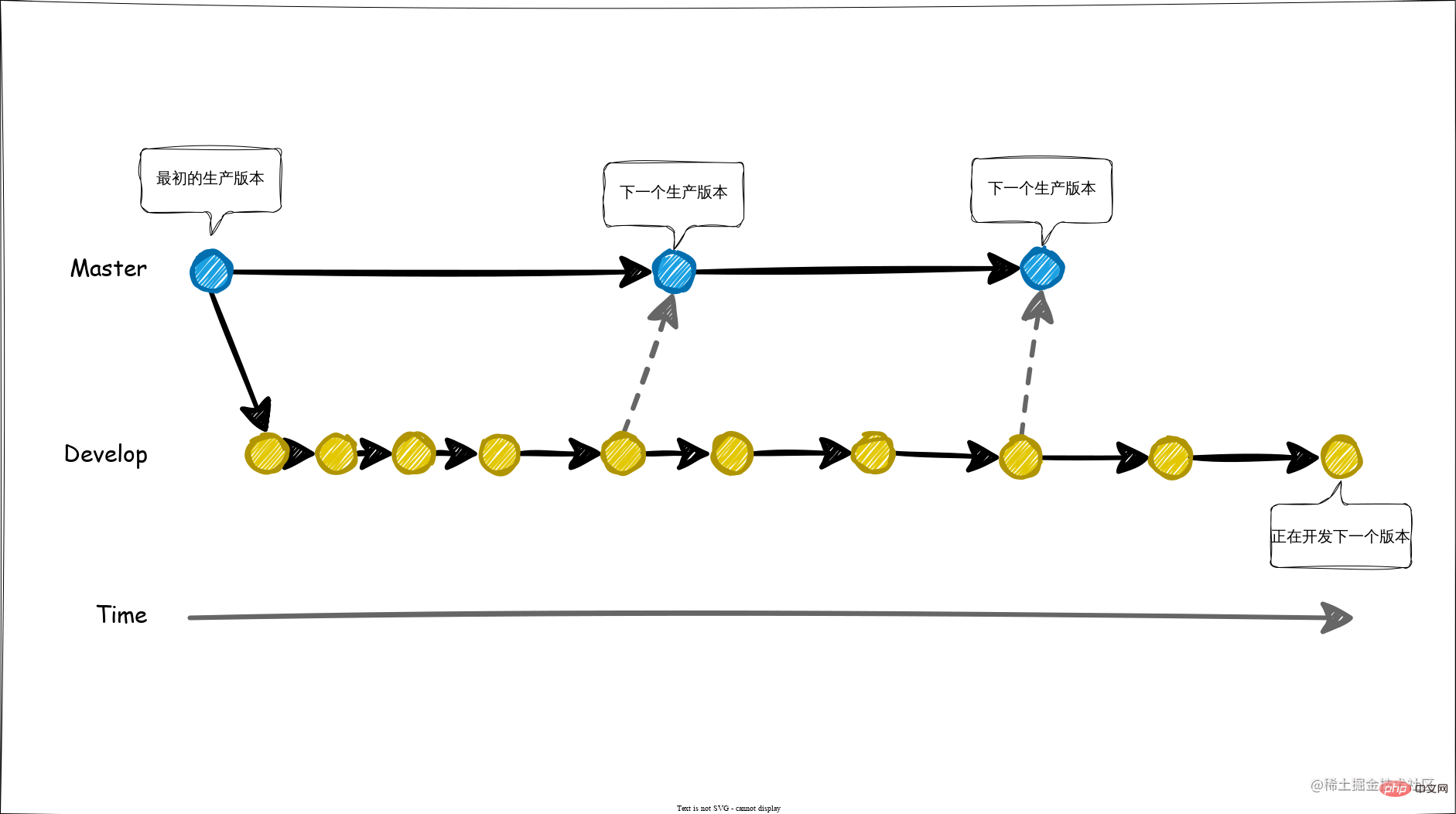
- master branch: used for release
- develop branch: used for development The relationship between the master branch and the develop branch is as above. The dotted line points to the two branches that are not directly related, but related through the release/hotfix branch
- feature branches: used for requirement development
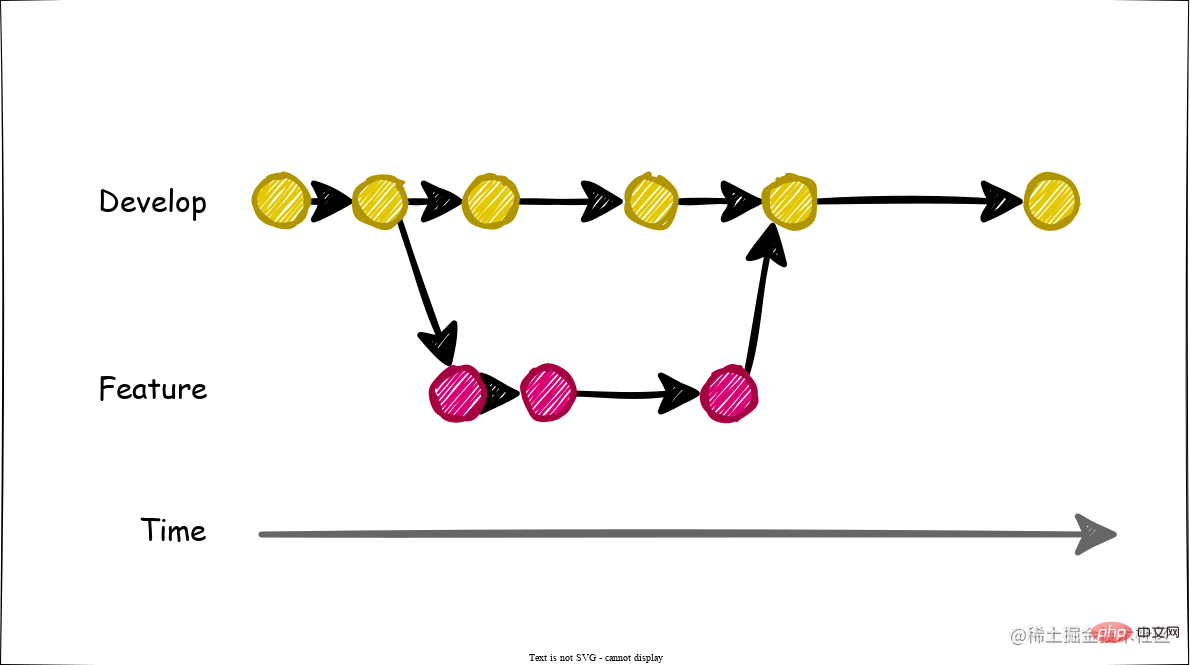
- release branches: used for release
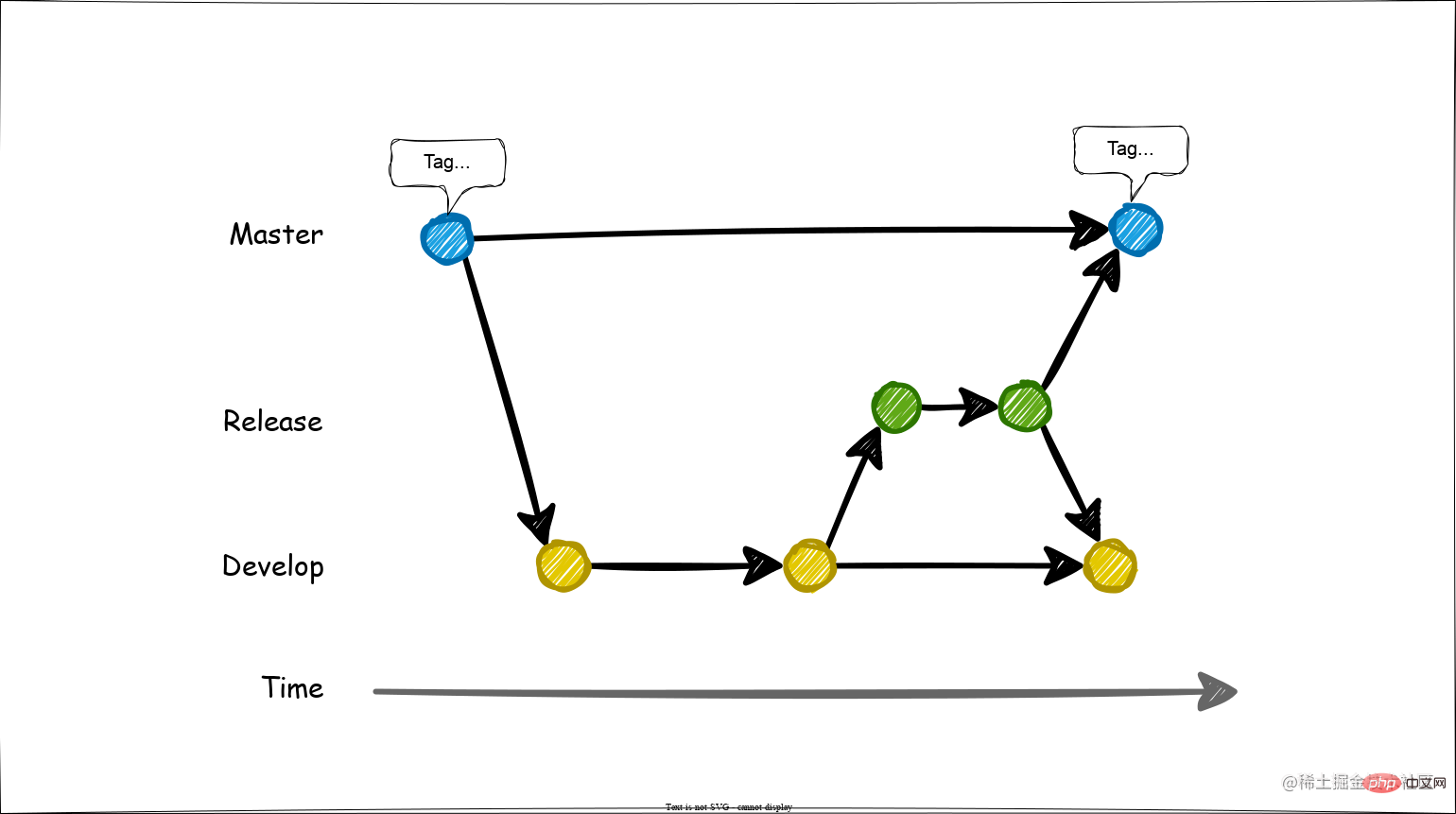
- hotfix branches: used to fix production problems
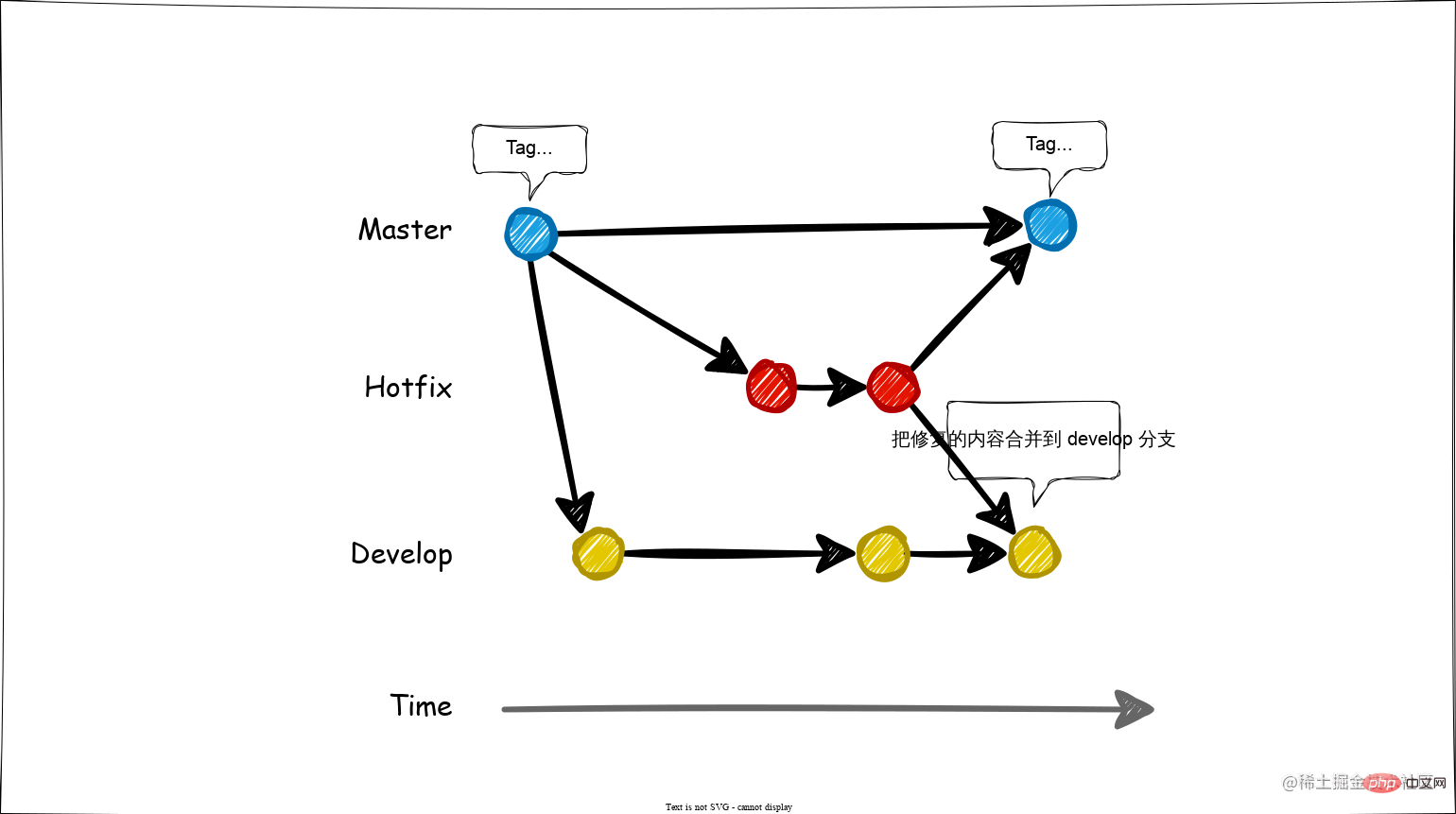
hotfix branches are used to fix bugs that urgently need to be fixed in the production environment. When a bug occurs in the production environment At that time, pull out the hotfix branch from the master branch, merge it back into the master branch for release after repair, and merge it into the develop branch before deleting it.
Finally review the complete gitflow

Added
In 2020 Vincent DriessenAdded a Reflection Note, roughly speakingGit FlowThis model seems complicated under continuous delivery software, you can consider using Github Flow instead of shoehorning Git Flow into the project.
FollowingGit FlowAdam Ruka forGit Flow## The technical details of # have been optimized and One Flow
Github Flow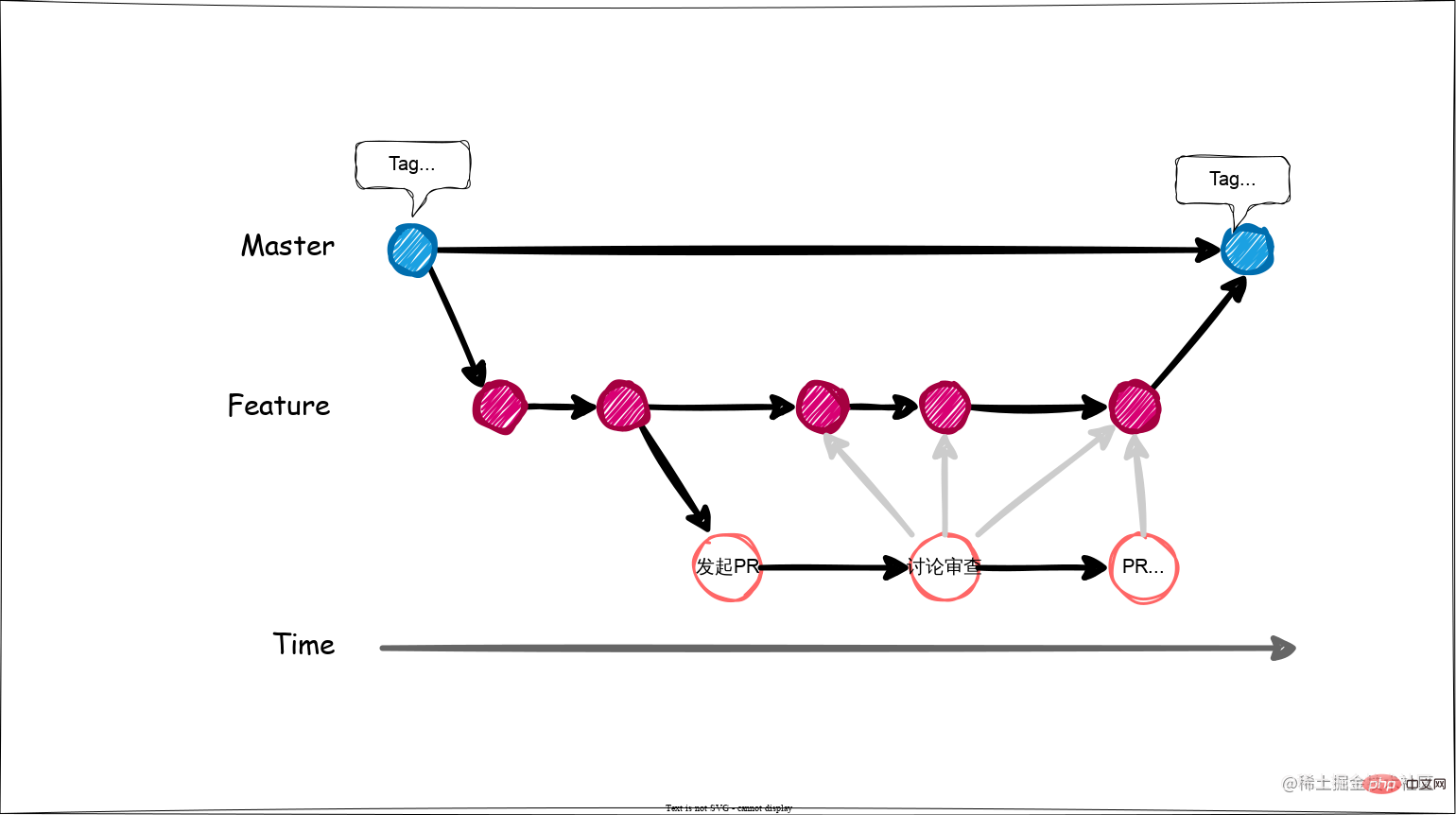 ## is proposed compared to
## is proposed compared to
Git Flow, Github Flow There is only one trunk branch, and the PR process is added through the github platform: When developing a certain function, pull out the feature branch from the master branch, submit a PR after completing the function, and let relevant personnel review it. During the review period, you can still submit the feature until it is confirmed that there are no problems and pass the PR to merge the feature branch into master. Branch for releaseGitLab Flow
GitLab Flow Use the master branch as the development branch, Based on the master branch, release the branch production
GitLab Flow Add The following branch definition:
Environment branch: Use
release branch## when you need to release different versions in different environments #: Used when the project needs to release different versions. After declaring a release branch, this branch will only merge serious bug fix updates. Continuous Release
gitlab-flow recommends using the master branch for development, and building a production branch based on the master branch for release. It also proposes the concept of environment branches. , merge layer by layer according to different environments, and finally summarize it into the production release branch for release 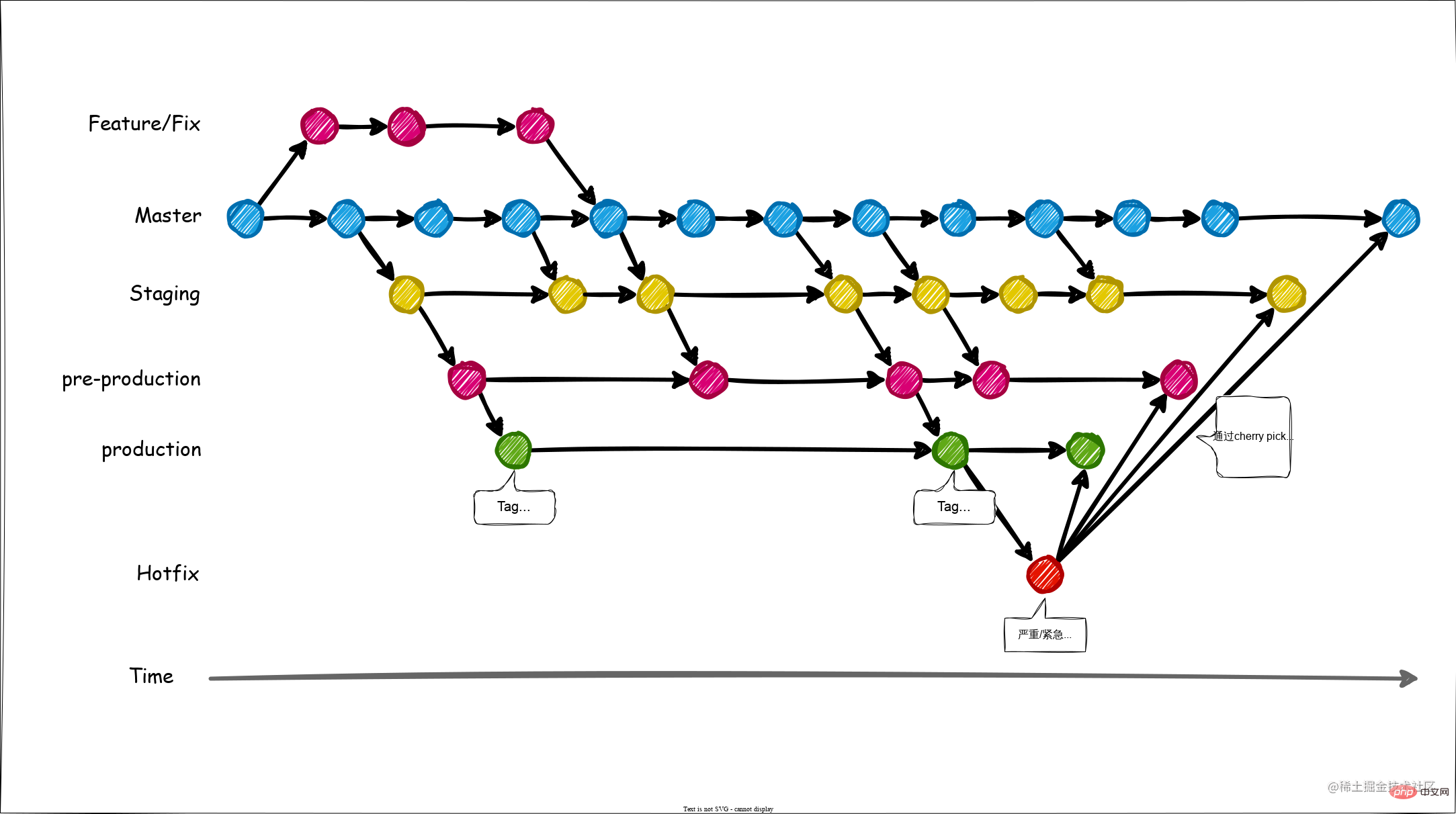
If your project needs to release different versions , the gitlab-flow version release mode may be more suitable. In the continuous release mode, different versions will be released in different release branches. 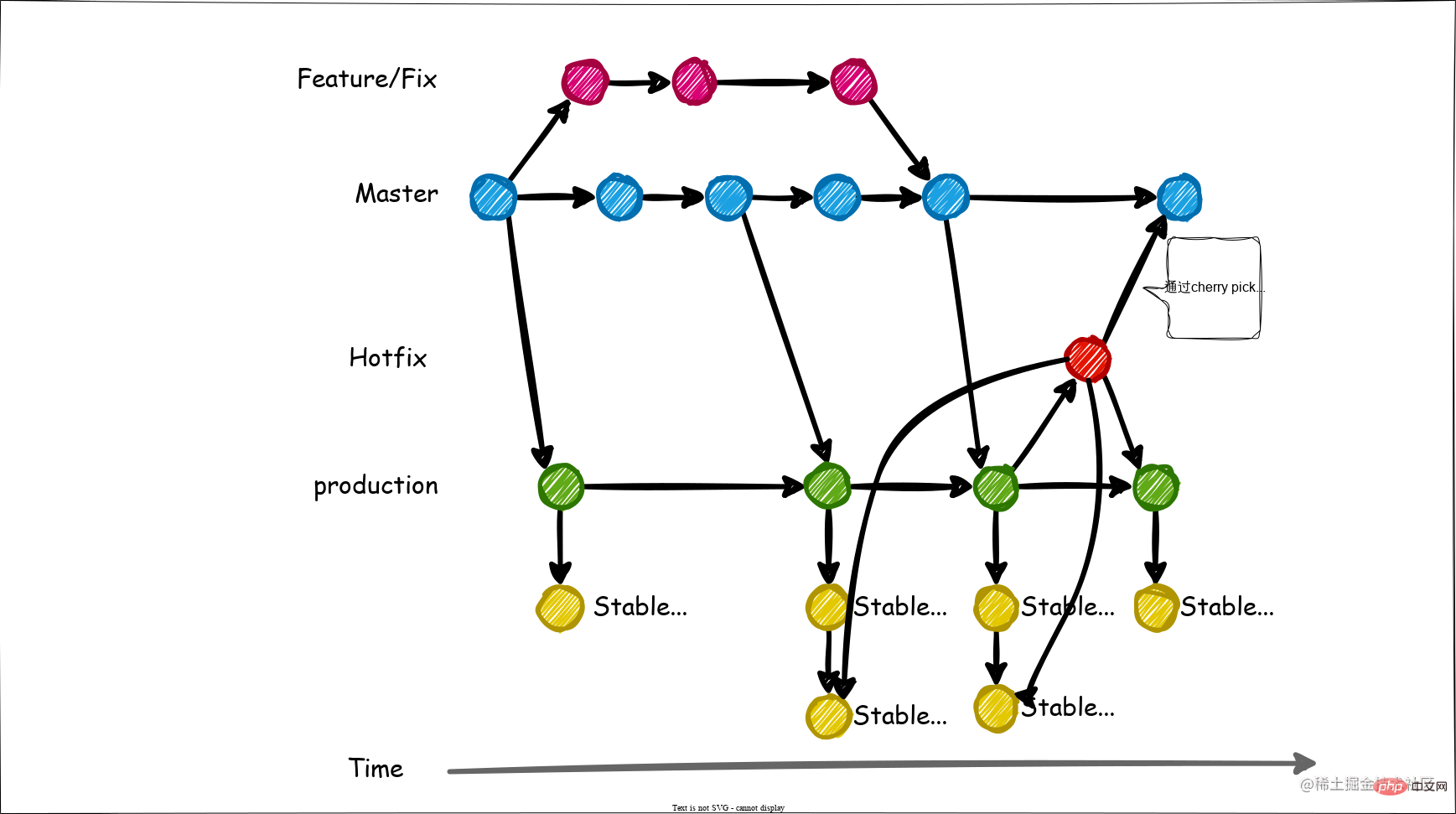
Aone-flow is based on the master branch, and other than the master branch are temporary branches. The environment branches are pulled out based on the master branch. There is no connection between the environment branches and they are developed independently. The environment branches are not allowed to be modified directly, but are combined by merging different feature branches. The feature branch will not be deleted until it is merged into the release branch. One advantage is that the operation granularity is higher and more controllable. The disadvantage is that even if the content of the environment branch is the same, the version history may be inconsistent. 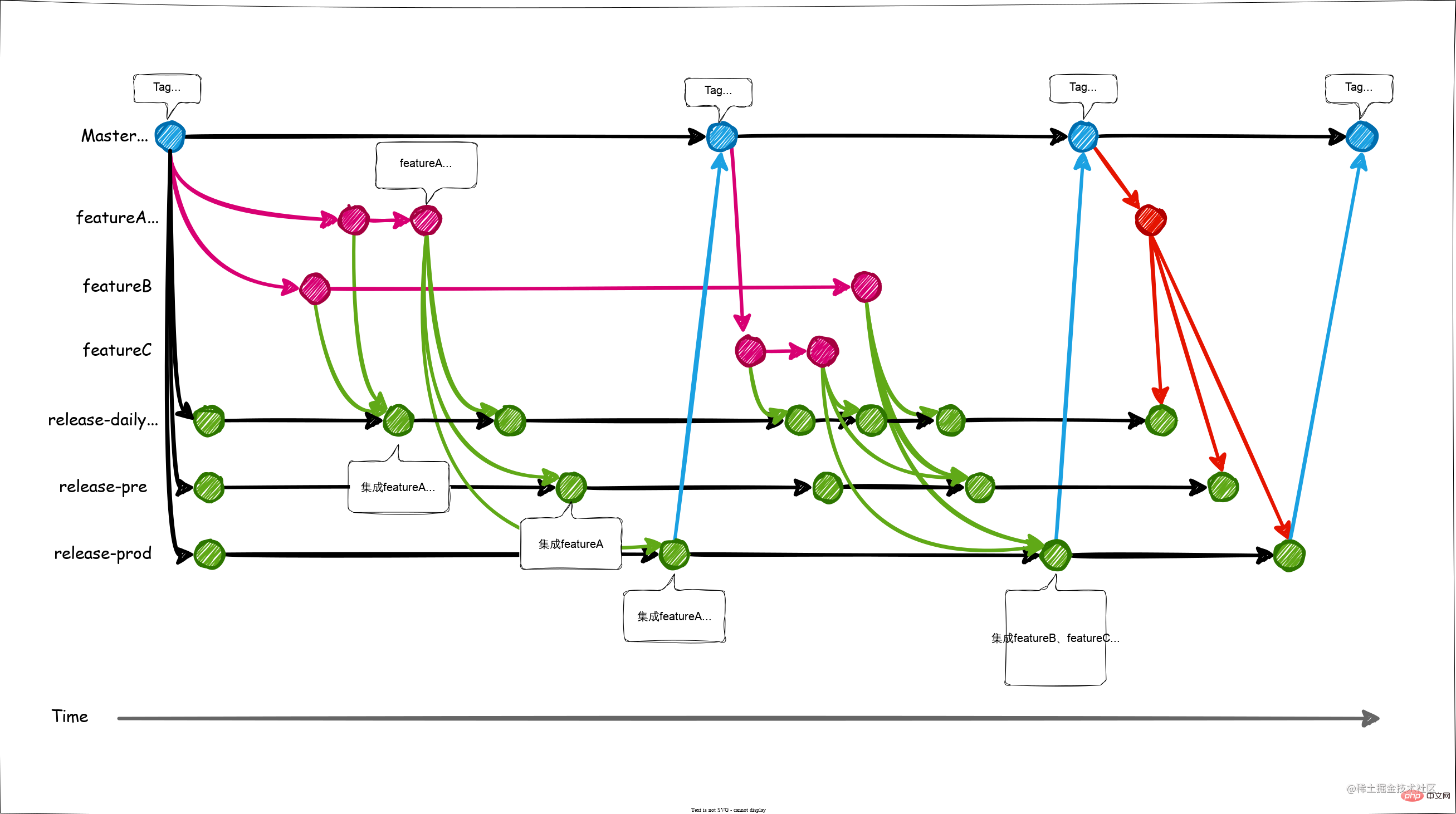
And github- flow proposes a minimalist version of flow in response to the complexity of gitflow;
gitlab-flow also proposes its own compromise solution for the overly complex or simple methods of gitflow and github-flow, and also provides Two delivery methods (continuous delivery, version delivery) solution;Finally, AoneFlow is also introduced, a solution with freer operating granularity.
In fact, there is no one-size-fits-all solution. Different teams/projects have their own special situations. For different situations, the flow is also changing, and the appropriate one is the best.
To conclude, always remember that panaceas don't exist. Consider your own context. Don't be hating. Decide for yourself.
QuoteVincent Driessen: "Finally, always remember that there is no magic bullet. Consider your own background. Don't hate. Decide for yourself"
More For programming related knowledge, please visit: programming video! !
The above is the detailed content of Get an in-depth understanding of Git's various workflows. For more information, please follow other related articles on the PHP Chinese website!

Hot AI Tools

Undresser.AI Undress
AI-powered app for creating realistic nude photos

AI Clothes Remover
Online AI tool for removing clothes from photos.

Undress AI Tool
Undress images for free

Clothoff.io
AI clothes remover

Video Face Swap
Swap faces in any video effortlessly with our completely free AI face swap tool!

Hot Article

Hot Tools

Notepad++7.3.1
Easy-to-use and free code editor

SublimeText3 Chinese version
Chinese version, very easy to use

Zend Studio 13.0.1
Powerful PHP integrated development environment

Dreamweaver CS6
Visual web development tools

SublimeText3 Mac version
God-level code editing software (SublimeText3)

Hot Topics
 1386
1386
 52
52
 How to delete a repository by git
Apr 17, 2025 pm 04:03 PM
How to delete a repository by git
Apr 17, 2025 pm 04:03 PM
To delete a Git repository, follow these steps: Confirm the repository you want to delete. Local deletion of repository: Use the rm -rf command to delete its folder. Remotely delete a warehouse: Navigate to the warehouse settings, find the "Delete Warehouse" option, and confirm the operation.
 What to do if the git download is not active
Apr 17, 2025 pm 04:54 PM
What to do if the git download is not active
Apr 17, 2025 pm 04:54 PM
Resolve: When Git download speed is slow, you can take the following steps: Check the network connection and try to switch the connection method. Optimize Git configuration: Increase the POST buffer size (git config --global http.postBuffer 524288000), and reduce the low-speed limit (git config --global http.lowSpeedLimit 1000). Use a Git proxy (such as git-proxy or git-lfs-proxy). Try using a different Git client (such as Sourcetree or Github Desktop). Check for fire protection
 How to generate ssh keys in git
Apr 17, 2025 pm 01:36 PM
How to generate ssh keys in git
Apr 17, 2025 pm 01:36 PM
In order to securely connect to a remote Git server, an SSH key containing both public and private keys needs to be generated. The steps to generate an SSH key are as follows: Open the terminal and enter the command ssh-keygen -t rsa -b 4096. Select the key saving location. Enter a password phrase to protect the private key. Copy the public key to the remote server. Save the private key properly because it is the credentials for accessing the account.
 How to download git projects to local
Apr 17, 2025 pm 04:36 PM
How to download git projects to local
Apr 17, 2025 pm 04:36 PM
To download projects locally via Git, follow these steps: Install Git. Navigate to the project directory. cloning the remote repository using the following command: git clone https://github.com/username/repository-name.git
 How to solve the efficient search problem in PHP projects? Typesense helps you achieve it!
Apr 17, 2025 pm 08:15 PM
How to solve the efficient search problem in PHP projects? Typesense helps you achieve it!
Apr 17, 2025 pm 08:15 PM
When developing an e-commerce website, I encountered a difficult problem: How to achieve efficient search functions in large amounts of product data? Traditional database searches are inefficient and have poor user experience. After some research, I discovered the search engine Typesense and solved this problem through its official PHP client typesense/typesense-php, which greatly improved the search performance.
 How to update code in git
Apr 17, 2025 pm 04:45 PM
How to update code in git
Apr 17, 2025 pm 04:45 PM
Steps to update git code: Check out code: git clone https://github.com/username/repo.git Get the latest changes: git fetch merge changes: git merge origin/master push changes (optional): git push origin master
 How to connect to the public network of git server
Apr 17, 2025 pm 02:27 PM
How to connect to the public network of git server
Apr 17, 2025 pm 02:27 PM
Connecting a Git server to the public network includes five steps: 1. Set up the public IP address; 2. Open the firewall port (22, 9418, 80/443); 3. Configure SSH access (generate key pairs, create users); 4. Configure HTTP/HTTPS access (install servers, configure permissions); 5. Test the connection (using SSH client or Git commands).
 How to add public keys to git account
Apr 17, 2025 pm 02:42 PM
How to add public keys to git account
Apr 17, 2025 pm 02:42 PM
How to add a public key to a Git account? Step: Generate an SSH key pair. Copy the public key. Add a public key in GitLab or GitHub. Test the SSH connection.




